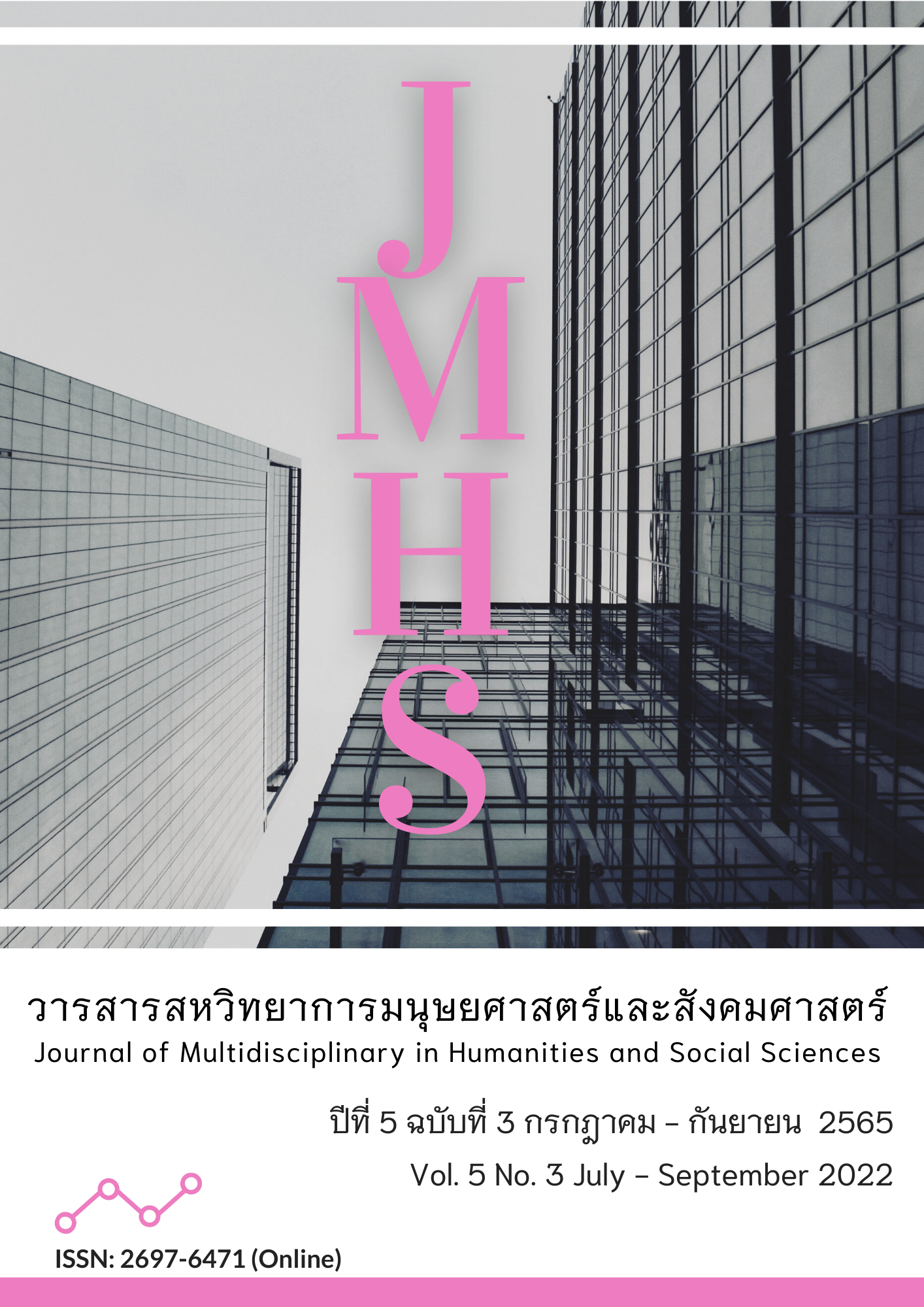Causal Factors Affecting Purchase Intention of Movies Watch on Disney Plus Hotstar Application in Thailand
Main Article Content
Abstract
The objectives of this research article were 1) to develop and validate the consistency of a causal relationship model of purchase intention of movies watched on the Disney Plus Hotstar application in Thailand and 2) to study causal factors affecting purchase intention of movies watched on the Disney Plus Hotstar application in Thailand. The sample group consisted of 400 people who had the purchase intention of watching movies on the Disney Plus Hotstar application in Thailand. The tools used in the research were online questionnaires. The statistics used in data analysis were frequency, percentage, and the structural equation model.
The results of this research were the development of causal relationship models consisting of 5 components, which were 1) corporate social responsibility (CSR), 2) trust, 3) brand image, 4) awareness, and 5) purchase intention and a model developed in accordance with empirical data. The statistics showed the Chi-square statistics goodness fit test (χ2) = 188.81, degrees of freedom (df) 138, CMIN/df = 1.37, GFI = 0.96, AGFI = 0.92, SRMR = 0.02, RMSEA = 0.03. The final result was a predictive coefficient of 0.64, indicating that the variables in the model can explain the purchase intention of movies watched on the Disney Plus Hotstar application of consumers in Thailand by 64% and that trust, awareness, and brand image influence the purchase intention of movies watched on the Disney Plus Hotstar application in Thailand.
Article Details

This work is licensed under a Creative Commons Attribution-NonCommercial-NoDerivatives 4.0 International License.
Views and opinions appearing in the Journal it is the responsibility of the author of the article, and does not constitute the view and responsibility of the editorial team.
References
กริช แรงสูงเนิน. (2554). การวิเคราะห์ปัจจัยด้วย SPSS และ AMOS เพื่อการวิจัย. กรุงเทพฯ: ซีเอ็ดยูเคชั่น.
จุลสวัสดิ์ ฑัชวงศ์ (2558). ความรับผิดชอบต่อสังคมขององค์กรกับผลกระทบที่มีต่อพฤติกรรมการเป็นสมาชิกองค์กรที่ดีของพนักงาน. วารสารปัญญาภิวัฒน์, 7(3), 251-262.
ดารารัตน์ ภูธร และ พิรงรอง รามสูต. (2561). การตระหนักรู้ของดิจิทัลเนทีฟไทยต่อการละเมิดลิขสิทธิ์การ์ตูนและแอนิเมชันญี่ปุ่นออนไลน์. วารสารการสื่อสารและการจัดการนิด้า, 4(2), 17-32.
ธัญนันท์ บุญอยู่. (2562). อิทธิพลของความไว้วางใจและการแบ่งปันความรู้ในฐานะปัจจัยคั่นกลางแบบอนุกรม ที่เชื่อมโยงความสัมพันธ์ระหว่างทุนทางจิตวิทยาสู่ผลการปฏิบัติงานของพนักงานวิสาหกิจขนาดย่อมของอุตสาหกรรม. วารสารสมาคมนักวิจัย, 24(1), 175-186.
ประภาเพ็ญ สุวรรณ. (2526). การวัดการเปลี่ยนแปลงและพฤติกรรมอนามัย. กรุงเทพฯ: ไทยวัฒนาพานิช.
ปารมี พัฒนดุล และวิโรจน์ เจษฎาลักษณ์. (2559). ปัจจัยที่มีผลต่อการตั้งใจซื้อผลิตภัณฑ์เพื่อสิ่งแวดล้อมของผู้บริโภค อำเภอปากเกร็ด จังหวัดนนทบุรี. Veridian E-Journal, Silpakorn University (Humanities, Social Sciences and arts), 9(2), 857-872.
ปารมี รอดกลิ่น และ วรพจน์ ปานรอด. (2562). ความไว้วางใจต่อการตัดสินใจซื้ออัญมณีและ เครื่องประดับบนตลาดออนไลน์ผ่านช่องทางการถ่ายทอดสดเฟซบุ๊กไลฟ์ (Facebook Live). วารสารเศรษฐศาสตร์และบริหารธุรกิจ มหาวิทยาลัยทักษิณ, 11(2), 21-30.
ปิยนุช พละเยี่ยม และ ชลิตา ศรีนวล. (2561). ความตั้งใจใช้บริการทางการเงินผ่านระบบพร้อมเพย์ของผู้บริโภคในเขตกรุงเทพมหานคร. วารสารปัญญาภิวัฒน์, 10(3), 154-163.
ผู้จัดการออนไลน์. (2564). “ดิสนีย์พลัส ฮอตสตาร์” ประเทศไทยเริ่มสตรีมทั่วประเทศ 30 มิถุนายน นี้. สืบค้นเมื่อ 22 พฤศจิกายน 2564, จาก https://mgronline.com/business/detail/9640000055 438
พณีพรรณ สมบัติ. (2564). การยอมรับความเสี่ยงในการตัดสินใจซื้อประกันสุขภาพออนไลน์ในเขตกรุงเทพมหานคร หลังสถานการณ์การระบาดของ Covid-19. วารสารศิลปการจัดการ, 5(3), 812-826.
มัสลิน ใจคุณ และ รุจิภาส โพธิ์ทองแสงอรุณ. (2561). การยอมรับเทคโนโลยี ความไว้วางใจ และการตลาดผ่านสังคมออนไลน์ที่มีผลต่อความตั้งใจซื้อสินค้าผ่านช่องทางเฟซบุ๊ก ไลฟ์ (Facebook LIVE) ของกลุ่มผู้บริโภค GENERATIONS X, Y, Z. วารสารวิชาการ สถาบันเทคโนโลยีแห่งสุวรรณภูมิ, 6(2), 260-275.
วจนา วรรลยางกูร. (2563). โรงภาพยนตร์ไม่มีวันตาย: มองโลกภาพยนตร์หลังวิกฤต กับ ก้อง ฤทธิ์ดี. สืบค้นเมื่อ 22 พฤศจิกายน 2564, จาก https://www.the101.world/film-industry-in-crisis/
สำนักงานพัฒนาธุรกรรมทางอิเล็กทรอนิกส์. (2564). รายงานผลการสำรวจพฤติกรรมผู้ใช้อินเทอร์เน็ตในประเทศไทย ปี 2563. สืบค้นเมื่อ 22 พฤศจิกายน 2564, จาก https://www.etda.or.th/th/newsevents/pr-news/ETDA-released-IUB-2020.aspx
อาภา เอกวานิช และ บุหงา ชัยสุวรรณ. (2562). ปัจจัยที่ส่งผลต่อความตั้งใจซื้อผลิตภัณฑ์ที่เป็นมิตรต่อสิ่งแวดล้อม. วารสารสุโขทัยธรรมาธิราช, 32(1), 125-140.
Bowen, H. R. (1953). Social Responsibilities of the Businessman. New York: Harper and Row.
Carroll, A. B. (1979). A Three-Dimensional Conceptual Model of Corporate Performance. The Academy of Management Review, 4(4), 497-505.
Crotts, J. C., & Turner, G. B. (1999). Determinants of Intra Firm Trust in Buyer Seller Relationships in the International Travel Trade. International Journal of Contemporary Hospitality Management, 11(2/3), 116-123.
Good, C. V. (1973). Dictionary of Education. New York: McGraw-Hill Book.
Hair, J. F., Black, W. C., Babin, B. J., & Anderson, R. E. (2010). Multivariate Data Analysis. (7th ed.). New York: Pearson.
Hoelter, J. W. (1983). The Analysis of Covariance Structures: Goodness-of-fit Indices. Sociological. Methods and Research, 11(3), 325-344.
Kang, J., & Kim, S. H. (2013). What are Consumers Afraid of? Understanding Perceived Risk toward the Consumption of Environmentally Sustainable Apparel. Family and Consumer Sciences Research Journal, 41(3), 267-283.
Kline, R. B. (2011). Principles and Practice of Structural Equation Modeling. (3rd ed.). New York: The Guildford Press.
Kotler, P., & Keller, K. L. (2016). Marketing Management. (15th ed.). Kendallville: Pearson.
Parengkuan, M. (2017). A Comparative Study between Male and Female Purchase Intention Toward Visual Merchandising at Centro by Parkson Department Store Mantos. Jurnal Berkala Ilmiah Efisiensi, 17(1), 9-21.
Zhang, Q., & Ahmad, S. (2021). Analysis of Corporate Social Responsibility Execution Effects on Purchase Intention with the Moderating Role of Customer Awareness. Sustainability, 13(8), 1-19. https://doi.org/10.3390/su13084548


